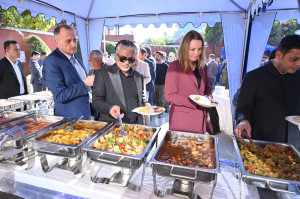Culture & Lifestyle
Untapped hot water springs
Sisne and Pelma locals lament the lack of their preservation and promotion.
Mahesh KC
Hot water springs located at the coast of Sanibheri in Pokhara, Sisne Village, Ward 4 and the banks of Remai River in Pelma, Putha Uttarganga, Ward 1, seem stranded because of a lack of conservational efforts and publicity. Locals believe that if these springs, which naturally spout hot water all year long, are conserved and promoted, then they can help develop the commercial tourism of the area.
80-year-old Dev Bahadur Khatri from Pokhara remembers swimming and bathing in the hot water spring at Sanibheri as a child. “It has been here for a long time. I used to come here a lot when I was younger. The spring has been producing hot water continuously ever since.”
Another local, Yamraj Khadka, said that even though the village municipality has launched campaigns time and again to try and preserve the hot water spring, they haven’t yielded any results. “The government should have made a result-oriented plan for conservation and implemented it. But all they do is randomly and haphazardly invest in incompetent plans,” stated Khadka.
Krishna Regmi, chairman of the Sisne village municipality, considers the hot water spring the major tourist attraction of the village. He said the municipality will make a comprehensive plan utilising the past investment to protect and promote the spring.
Chairman of Putha Uttarganga, Ward 1, Jas Bahadur Sirpali, claims that there are 12 hot water springs around the Rimui River in Polma. Veerman Vick, a local, said that the hot water spring being so near the Remai River is quite significant. “A hot water spring being beside a river that originates in the mountains is unusual. This will spark the interest of many national and international tourists. So, we should conserve and publicise the stream,” he added.
People from all over Nepal come to bathe in the hot springs of Pokhara and Pelma—especially in winter. Because of the absence of good roads, only locals and residents of nearby villages can reach the hot springs of Pelma. Pokhara’s hot springs, on the other hand, get a lot of footfall. Inhabitants of East Rukum and many neighbouring districts all come to bathe there.
Janak KC, a local of Pokhara, said that because only a dam is built in the Pokhara spring, which is located near the district’s headquarter Rukumkot, there is a risk of damage to the structure during the monsoon season when floods are possible in the Sanibheri River. “A more thought-out plan for its conservation is needed. What we are doing now isn’t enough,” he said.
On the other hand, only a pond has been built in the Pelma hot springs. Local Purna Kami believes that the conservation efforts should include collecting the hot water from all the springs in a single place. “People come to bathe in these springs because it is said that the hot water cures skin diseases,” said Kami.




 11.12°C Kathmandu
11.12°C Kathmandu




%20(1).jpg&w=200&height=120)










